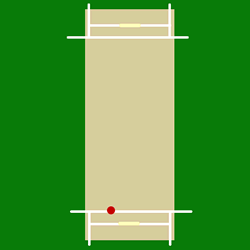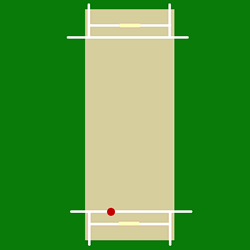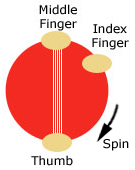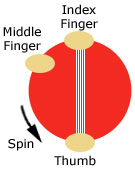
Leg spin is a type of spin bowling in cricket. A bowler who uses this technique is called a leg spinner. Leg spinners bowl with their right-arm and a wrist spin action. The leg spinner's normal delivery is called a leg break, which spins from right to left when the ball bounces on the pitch. For a right-handed batter, the ball breaks towards them from the leg side, hence the name 'leg break'.

Left-arm unorthodox spin, also known as slow left-arm wrist spin, is a type of spin bowling in the sport of cricket. Left-arm unorthodox spin bowlers use wrist spin to spin the ball, and make it deviate, or 'turn' from left to right after pitching. The direction of turn is the same as that of a traditional right-handed off spin bowler, although the ball will usually turn more sharply due to the spin being imparted predominantly by the wrist.

Off spin is a type of spin bowling in cricket. A bowler who uses this technique is called an off spinner. Off spinners bowl with their right-arm and a finger spin action. Their normal delivery is called an off break, which spins from left to right when the ball bounces on the pitch. For a right-handed batsman, the ball breaks towards them from the off side, hence the name 'off break'.
A googly, also known as a wrong'un or Bosie, is a type of delivery in the game of cricket bowled by a right-arm leg spin bowler. It is different from the normal delivery for a leg-spin bowler in that it is turning the other way. The googly is not a variation of the typical off spin type of delivery, in that the cricket ball is presented from the bowler's hand in such a way that once the ball pitches; instead, it deviates in the opposite direction of a leg spinning type of delivery. It has also been colloquially referred to as the wrong'un, Bosie or Bosey, with the latter two eponyms referring to Bernard Bosanquet, the bowler who originally devised and began using the googly. He first employed it in July 1900, during the second innings of a County Championship match between Middlesex and Leicestershire at Lord's. In that game, Sam Coe became the first batter known to have been dismissed by a googly. During the Edwardian era, some considered its use to be an example of cheating.
A topspinner is a type of delivery bowled by a cricketer bowling either wrist spin or finger spin. In either case, the bowler imparts the ball with top spin by twisting it with his or her fingers prior to delivery. In both cases, the topspinner is the halfway house between the stock delivery and the wrong'un - in the wrist spinner's case his googly, and in the finger spinner's case his doosra.
A doosra is a particular type of delivery by an off-spin bowler in cricket. The doosra spins in the opposite direction to an off break, and aims to confuse the batter into playing an unavoidable shot.

Spin bowling is a bowling technique in cricket, in which the ball is delivered relatively slowly but with rapid rotation, giving it the potential to deviate sharply after bouncing. A bowler who uses this technique is called a spinner, a spin bowler, or a slow bowler.
An arm ball is a type of delivery in cricket. It is a variation delivery bowled by an off spin bowler or slow left-arm orthodox bowler. It is the finger spin equivalent of a wrist spinner's slider or zooter.

A leg cutter is a type of delivery in the sport of cricket. It is bowled by fast bowlers.

An off cutter is a type of delivery in the game of cricket. It is bowled by fast bowlers.
In the sport of cricket there are two broad categories of bowlers: pace and spin. Pace bowlers rely mostly on the speed of the ball to dismiss batsmen, whereas spin bowlers rely on the rotation and turn off the ball to deceive the batter.

A delivery or ball in cricket is a single action of bowling a cricket ball toward the batter. Once the ball has been delivered, batters may attempt to score runs, with the bowler and other fielders attempting to stop this by getting the batters out. When the ball becomes dead, the next delivery can begin.
The Ball of the Century, also referred to as the Gatting Ball or simply That Ball, is a cricket delivery bowled by Australian spin bowler Shane Warne to English batter Mike Gatting on 4 June 1993, the second day of the first Test of the 1993 Ashes series, at Old Trafford in Manchester. With his first ball against England, in his first Ashes Test, Warne produced a spectacular delivery that bowled Gatting out. It became recognised as being of significance not just in the context of the match, but more generally in signalling a revival of leg spin bowling.
Wrist spin is a type of bowling in the sport of cricket. It refers to the cricket technique and specific hand movements associated with imparting a particular direction of spin to the cricket ball. The other spinning technique, usually used to spin the ball in the opposite direction, is finger spin. Wrist spin is bowled by releasing the ball from the back of the hand, so that it passes over the little finger. Done by a right-handed bowler, this imparts an anticlockwise rotation to the ball, as seen from the bowler's perspective; a left-handed wrist spinner rotates the ball clockwise.
Finger spin is a type of bowling in the sport of cricket. It refers to the technique and specific hand movements associated with imparting a particular direction of spin to the cricket ball. The other spinning technique, generally used to spin the ball in the opposite direction, is wrist spin. Although there are exceptions, finger spinners generally turn the ball less than wrist spinners. However, because the technique is simpler and easier to master, finger spinners tend to be more accurate.

Leslie O'Brien "Chuck" Fleetwood-Smith was a cricketer who played for Victoria and Australia. Known universally as "Chuck", he was the "wayward genius" of Australian cricket during the 1930s. A slow bowler who could spin the ball harder and further than his contemporaries, Fleetwood-Smith was regarded as a rare talent, but his cricket suffered from a lack of self-discipline that also characterised his personal life. In addition, his career coincided with those of Bill O'Reilly and Clarrie Grimmett, two spinners named in the ten inaugural members of the Australian Cricket Hall of Fame; as a result he played only ten Test matches but left a lasting impression with one delivery in particular. His dismissal of Wally Hammond in the fourth Test of the 1936–37 Ashes series has been compared to Shane Warne's ball of the century. He has the unwanted record of conceding the most runs by a bowler in a Test match innings.

In ball sports, topspin or overspin is a property of a ball that rotates forwards as it is moving. Topspin on a ball propelled through the air imparts a downward force that causes the ball to drop, due to its interaction with the air. Topspin is the opposite of backspin.
In cricket, a slider is a type of delivery bowled by a wrist spin bowler. While a topspinner is released with the thumb facing the batter, a slider is bowled in a similar manner to a legbreak, but instead of imparting sidespin with the third finger, the bowler allows his fingers to roll down the back of the ball, providing a mixture of sidespin and backspin. Whereas a topspinner tends to dip more quickly and bounce higher than a normal delivery, a slider does the opposite: it carries to a fuller length and bounces less than the batter might expect. The sliders will typically head towards the batter with a scrambled seam. This has less effect on the flight and bounce but absence of leg spin may deceive the batter. Frequently the slider is bowled with a mixture of side spin and backspin. This has the effect of making the ball harder to differentiate from the leg break for the batters without reducing the mechanical effects caused by the backspin. This delivery may skid straight on or it may turn a small amount.
The carrom ball is a style of spin bowling delivery used in cricket. The ball is released by flicking it between the thumb and a bent middle finger in order to impart spin.







